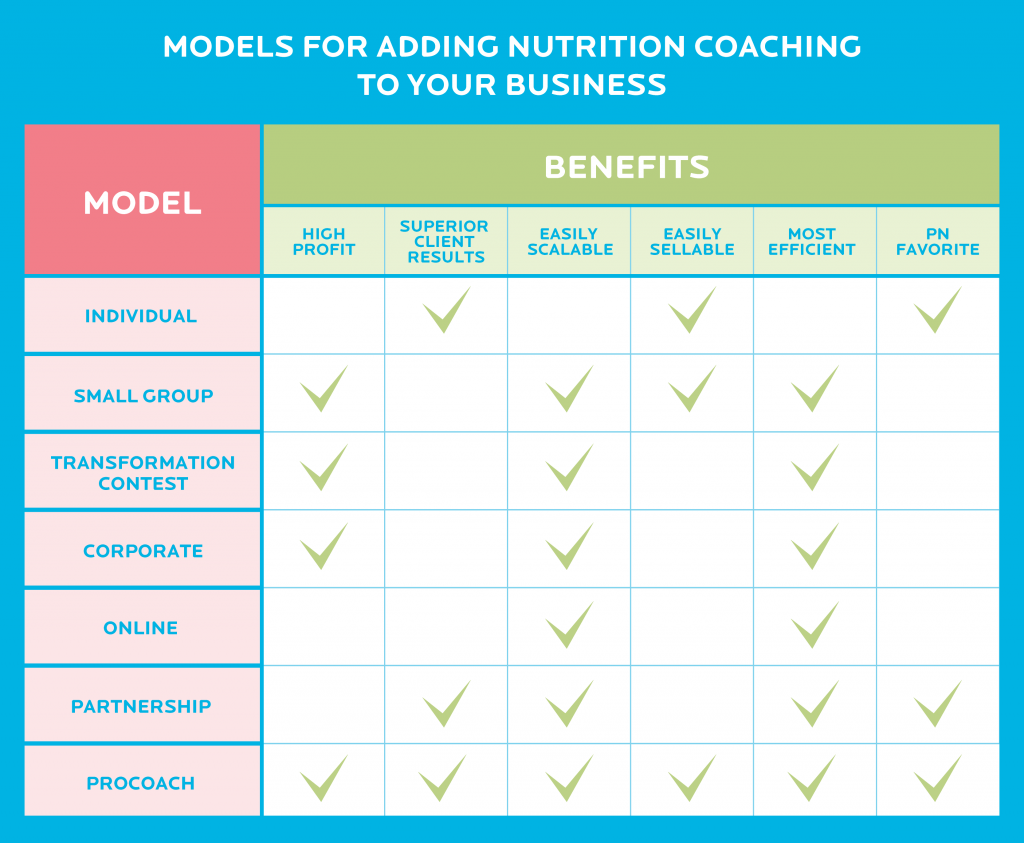Everyone needs a team.
As a health coach, you can become an expert in multiple areas: nutrition, behavior change psychology, fitness and athletic performance, stress management and recovery, and more.
However, no matter how many certifications you earn, you’ll invariably encounter clients with progress-blocking problems you don’t have the skills, training, expertise, or legal right to solve.
Here’s the thing…
You may not be an expert at fixing marriages, treating GERD, or counseling someone with an eating disorder, but someone else is.
Here’s where a healthy referral network comes in.
By connecting your client with such a person, you get to stay within your scope of practice, give welcome business to respected colleagues, and help your client solve their problem.
(Total. Supercoach. Move.)
All of our certification programs include sections devoted to teaching coaches how to build robust referral networks of professionals skilled at solving common client problems.
In this article, we’ll discuss how to do that—by exploring the top mistakes we see coaches make. Avoid them, and you’ll be able to refer out with confidence.
First, what’s a referral network?
A referral network is a list of supplementary professionals, businesses, and resources that benefit clients.
Your network might include local or virtual:
- Medical doctors, psychologists, registered dietitians, and other professionals with the training and credentials to help clients with problems outside of your scope of practice. (For an in-depth refresher, see our Scope of Practice worksheet.)
- Fellow health coaches and personal trainers with deep knowledge in an area outside your experience. (For example, maybe a client is interested in learning yoga, but you haven’t the faintest idea of how to salute the sun.)
- Workshops, fitness groups, webinars, food services, and other resources that support clients during their behavior change journey.
To confidently refer clients to skilled practitioners with excellent reputations, you’ll want to do some legwork. That brings us to the top mistakes to avoid.
Mistake #1: You build your network before launching your business.
For recently certified health coaches, the task “create a referral network” can double as a procrastination tool, says PN’s Director of Community Engagement Kate Solovieva.
Rather than take on clients, these coaches search for an increasing number of professionals, valiantly trying to be prepared for every potential referral situation. Yet, as much as they continue to work on it, their list is never “complete.”
That’s because…
“We can’t be prepared for everything,” says Solovieva.
The solution
Take on clients as soon as you’re certified.
Yes! That might sound scary, but the best way to figure out your “gaps” is to begin your practice, and see where your clients actually need help beyond what you can offer.
Add folks to your referral network over time as you:
- Connect with professionals on LinkedIn and other virtual networking sites
- Lean into peer networks (such as the Precision Nutrition Facebook communities)
- Mingle with members of your local Chamber of Commerce
- Chat with family, friends, and clients about professionals and resources they love
- Attend health conventions and other local events where a variety of health professionals tend to congregate
- Search for (and try out!) providers based on your own health needs
Who belongs in your referral network?
Use the following resource list as inspiration.
| Resource | Name | Website | Contact information |
| Acupuncturist | |||
| Chiropractor | |||
| Cooking class | |||
| Cycling, hiking, walking, or running club | |||
| Exercise physiologist | |||
| Coach who specializes in plant-based diets / pre- or post-natal fitness / other coaching niche you don’t cater to | |||
| Marriage / family counselor | |||
| Massage therapist | |||
| Meal delivery service | |||
| Mental health professional | |||
| Orthopedist | |||
| Pelvic floor therapist | |||
| Primary care physician | |||
| Physiotherapist | |||
| Registered dietitian | |||
| Stress management class | |||
| Other |
Mistake #2: You assume your referral list will cover all client needs.
As we mentioned above, you’ll never be able to anticipate every referral or client question ahead of time—and that’s okay.
This is especially true if you coach virtually with clients worldwide.
(You might know three fantastic massage therapists where you live in Toronto, Canada, but that knowledge won’t help if your client is based in Wellington, New Zealand.)
Similarly, some professionals or resources might work for some clients, but not others.
(You might, for example, know of several meal delivery options, yet none are suitable for that plant-based client who’s on a strict gluten-free diet.)
The solution
Learn how to help clients find the professionals and resources they need.
You might:
- Ask clients to describe their preferences. (Do they prefer working with a specific gender? Do they want to meet in person or online? Do they like the eagerness and creativity of a newer professional, or the “I’ve seen it all” sageness of a more seasoned pro?)
- Devote a coaching session to searching online for potential professionals and services together.
- Encourage clients to contact three practitioners, ask questions, and use what they learn to pick a winner.
Mistake #3: You let social awkwardness derail networking opportunities.
Reaching out to a stranger requires some bravery. You have to put yourself out there, explain who you are and what your motives are, and risk being ignored or turned down.
This is where many coaches get stuck, says Toni Bauer, PN’s Director of Coaching and Education Operations.
As a result, many coaches may put off the conversation.
The solution
Turn networking into a challenge. Coach Solovieva calls it “Operation 100.”
- Set a goal to contact 100 professionals over 12 months.
- Work toward your goal every week for about 20 minutes.
- Follow up with each non-responder once or twice.
- Instead of expecting a “yes” from every person you approach, understand that only about 10 percent of people will get back to you.
To ease yourself into the challenge, draft your elevator pitch, suggests Bauer.
Don’t overthink this. Your pitch doesn’t have to be a multi-page persuasive essay. Nor does it have to contain magical talking points. Just be yourself.
The elevator pitch: How to introduce yourself to a potential referral
As you work on your elevator pitch, use the examples below for inspiration.
“I’m a health coach who works with corporate executives. However, some of my clients would benefit from someone with your expertise. I would like to recommend you to my clients as those needs arise. Are you open to that?”
Or:
“I’m a health coach who works with athletes. Occasionally, my clients need guidance that I can’t always provide. I admire the work you’re doing, and I’d love to be able to refer people to you. If you’re open to that, could we have a quick 15- or 20-minute meeting to discuss what that arrangement would look like?”
Or simply:
“I’m a health coach and I’m building a referral list of practitioners. I would love to refer clients to you. Are you taking new patients right now?”
Mistake #4: You use dated persuasion tactics.
If you use LinkedIn, then you’ve likely been on the receiving end of old-school cold sales tactics. We’re talking direct messages from strangers who clearly haven’t read anything on your profile and know nothing about you.
These spammy messages are as welcome as a stranger who sidles up to you at a bar and says, “So, wanna come back to my place?”
We’re not here to discourage you from using cold outreach. It has a place. However, to increase your response rate, we’d like to introduce you to a rarely used technique.
The solution
Get to know people before making an online ask, suggests Coach Solovieva.
Follow them, read their content, download and consume their free resources, comment on their posts, congratulate them on career wins, and become a part of their online life.
Do that, and people will remember you. More of them will respond to your messages, too. Plus, the intel you gather by forming a relationship will help you avoid…
Mistake #5: You don’t personally vet referrals.
How do you ensure you refer clients to compassionate professionals who truly know what they’re doing?
It involves more than checking someone’s website or social media profile.
If you only look at someone’s website or social media posts, “You’re just vetting their confidence and copywriting skills,” says Solovieva. “If we’re fortunate, confidence and copywriting go hand in hand with ability, but not always.”
The solution
Try out their services. Take someone’s yoga or Zumba class. Book a massage. Ask a medical professional to look at your creaky knee.
That way, you can see the professional in action.
If you’re thinking, ‘I don’t need some of the services my clients need!’ you’ve got a couple of options:
- Offer to pay a professional to meet with you for 30 to 60 minutes so you can ask some questions, get a sense of their treatment philosophy, and chat about referring clients to them.
- Interact with people in local social networking communities like NextDoor.com. Ask group members if they’ve seen a practitioner and, if so, whether they’d recommend the person.
Mistake #6: You sell clients too hard on your referrals.
When you recommend a professional you’ve personally vetted, it’s natural to want your client to take action.
However, despite your hard work, some clients just won’t make an appointment with the professional in question—and that’s okay.
“Let your clients be adults,” says Coach Bauer.
Clients have their reasons. Maybe their insurance won’t cover the service in question. Or, maybe they decided to see someone else.
“It’s not your responsibility for the relationships to be perfect or to flourish,“ says Bauer.
A cycle of support
Some coaches fear referrals because they see them as “giving business away.”
In reality, however, when you refer clients to solid pros, your clients simply feel like you have their back. (Which means they’ll be more likely to refer friends and family to you.)
Plus, when you send business towards another respected colleague, it also puts you on their radar for a cross-referral.
It’s good for your clients, good for business, and good for your community of health pros at large.
If you’re a coach, or you want to be…
You can help people build sustainable nutrition and lifestyle habits that will significantly improve their physical and mental health—while you make a great living doing what you love. We'll show you how.
If you’d like to learn more, consider the PN Level 1 Nutrition Coaching Certification. (You can enroll now at a big discount.)




Share